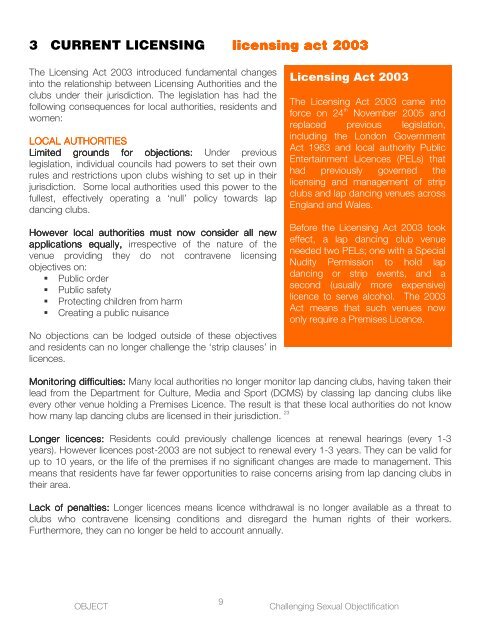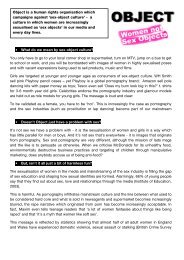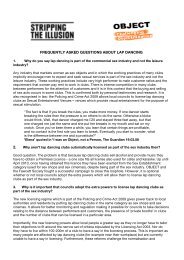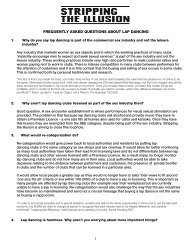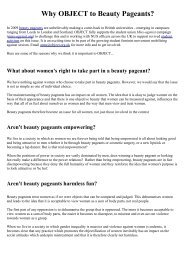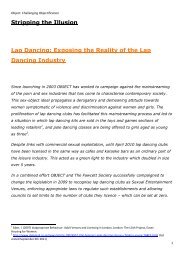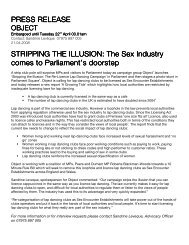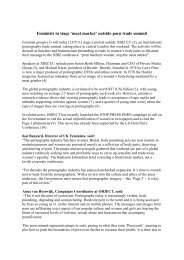a growing tide: local authorities restricted by inadequate ... - Object
a growing tide: local authorities restricted by inadequate ... - Object
a growing tide: local authorities restricted by inadequate ... - Object
Create successful ePaper yourself
Turn your PDF publications into a flip-book with our unique Google optimized e-Paper software.
3 CURRENT LICENSING licensing act 2003<br />
The Licensing Act 2003 introduced fundamental changes<br />
into the relationship between Licensing Authorities and the<br />
clubs under their jurisdiction. The legislation has had the<br />
following consequences for <strong>local</strong> <strong>authorities</strong>, residents and<br />
women:<br />
LOCAL AUTHORITIES<br />
Limited grounds for objections: Under previous<br />
legislation, individual councils had powers to set their own<br />
rules and restrictions upon clubs wishing to set up in their<br />
jurisdiction. Some <strong>local</strong> <strong>authorities</strong> used this power to the<br />
fullest, effectively operating a ‘null’ policy towards lap<br />
dancing clubs.<br />
However <strong>local</strong> <strong>authorities</strong> must now consider all new<br />
applications equally, irrespective of the nature of the<br />
venue providing they do not contravene licensing<br />
objectives on:<br />
Public order<br />
Public safety<br />
Protecting children from harm<br />
Creating a public nuisance<br />
No objections can be lodged outside of these objectives<br />
and residents can no longer challenge the ‘strip clauses’ in<br />
licences.<br />
Licensing Act 2003<br />
The Licensing Act 2003 came into<br />
force on 24 th<br />
November 2005 and<br />
replaced previous legislation,<br />
including the London Government<br />
Act 1963 and <strong>local</strong> authority Public<br />
Entertainment Licences (PELs) that<br />
had previously governed the<br />
licensing and management of strip<br />
clubs and lap dancing venues across<br />
England and Wales.<br />
Before the Licensing Act 2003 took<br />
effect, a lap dancing club venue<br />
needed two PELs; one with a Special<br />
Nudity Permission to hold lap<br />
dancing or strip events, and a<br />
second (usually more expensive)<br />
licence to serve alcohol. The 2003<br />
Act means that such venues now<br />
only require a Premises Licence.<br />
Monitoring difficulties: Many <strong>local</strong> <strong>authorities</strong> no longer monitor lap dancing clubs, having taken their<br />
lead from the Department for Culture, Media and Sport (DCMS) <strong>by</strong> classing lap dancing clubs like<br />
every other venue holding a Premises Licence. The result is that these <strong>local</strong> <strong>authorities</strong> do not know<br />
how many lap dancing clubs are licensed in their jurisdiction. 23<br />
Longer r licences: Residents could previously challenge licences at renewal hearings (every 1-3<br />
years). However licences post-2003 are not subject to renewal every 1-3 years. They can be valid for<br />
up to 10 years, or the life of the premises if no significant changes are made to management. This<br />
means that residents have far fewer opportunities to raise concerns arising from lap dancing clubs in<br />
their area.<br />
Lack of penalties: Longer licences means licence withdrawal is no longer available as a threat to<br />
clubs who contravene licensing conditions and disregard the human rights of their workers.<br />
Furthermore, they can no longer be held to account annually.<br />
OBJECT<br />
9<br />
Challenging Sexual <strong>Object</strong>ification


